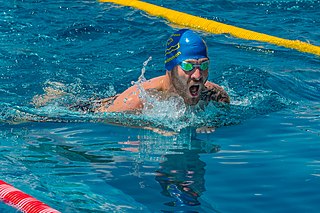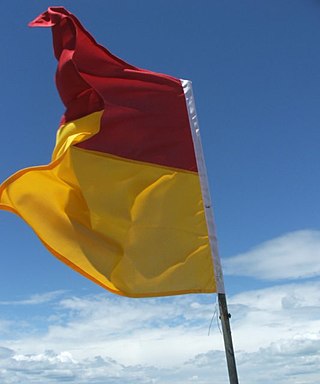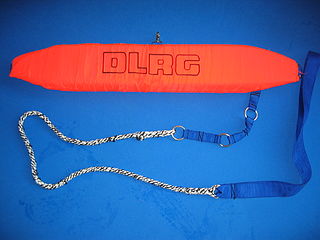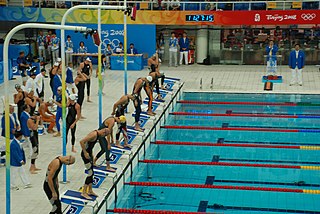
Swimming is the self-propulsion of a person through water, or other liquid, usually for recreation, sport, exercise, or survival. Locomotion is achieved through coordinated movement of the limbs and the body to achieve hydrodynamic thrust that results in directional motion. Humans can hold their breath underwater and undertake rudimentary locomotive swimming within weeks of birth, as a survival response.

A triathlon is an endurance multisport race consisting of swimming, cycling, and running over various distances. Triathletes compete for fastest overall completion time, racing each segment sequentially with the time transitioning between the disciplines included. The word is of Greek origin, from τρεῖς or treis (three) and ἆθλος or athlos (competition).

Water skiing is a surface water sport in which an individual is pulled behind a boat or a cable ski installation over a body of water, skimming the surface on two skis or one ski. The sport requires sufficient area on a stretch of water, one or two skis, a tow boat with tow rope, two or three people, and a personal flotation device. In addition, the skier must have adequate upper and lower body strength, muscular endurance, and good balance.

A swimsuit is an item of clothing designed to be worn by people engaging in a water-based activity or water sports, such as swimming, diving and surfing, or sun-orientated activities, such as sun bathing. Different types may be worn by men, women, and children. A swimsuit can be described by various names, some of which are used only in particular locations, including swimwear, bathing suit, swimming costume, bathing costume, swimming suit, swimmers, swimming togs, bathers, cossie, or swimming trunks for men, besides others.

A lifeguard is a rescuer who supervises the safety and rescue of swimmers, surfers, and other water sports participants such as in a swimming pool, water park, beach, spa, river and lake. Lifeguards are trained in swimming and CPR/AED first aid, certified in water rescue using a variety of aids and equipment depending on requirements of their particular venue. In some areas, lifeguards are part of the emergency services system to incidents and in some communities, lifeguards may function as the primary EMS provider.
Long-distance swimming is distinguished from ordinary swimming in that the distances involved are longer than are typically swum in pool competitions. When a given swim calls more on endurance than on outright speed, it is the more likely to be considered a long-distance swim. Long-distance swims, however, may take place in pools, such as the 1st official 24 hours World Championship in 1976 won by Peppo Biscarini with a record of 83.7 km or the current 25 meter pool world record of 2008 Olympic gold medalist Maarten van der Weijden. Some of the better-known long-distance swims are crossings of the English Channel, Catalina Channel, Fehmarn Belt and Cook Strait.
Due to the nature of triathlons as a race consisting of multiple sports many pieces of technical equipment have been borrowed from other sports, or developed specifically in an effort to race faster and improve a competitors safety.

Competitive swimwear refers to the swimsuit, clothing, equipment, and accessories used in the aquatic sports of swimming, diving, synchronized swimming, triathlon, and water polo.

TYR Sport, Inc. is an American designer, developer and manufacturer of competitive swim and triathlon apparel and related specialized athletics gear. It shares ownership with Swimwear Anywhere.

An aquathlon is a multisport race consisting of continuous run and swim elements. Competitors complete a swim immediately followed by a run over various distances. Athletes compete for fastest overall course completion, including the time transitioning between the disciplines.

Finswimming is an underwater sport consisting of four techniques involving swimming with the use of fins either on the water's surface using a snorkel with either monofins or bifins or underwater with monofin either by holding one's breath or using open circuit scuba diving equipment. Events exist over distances similar to swimming competitions for both swimming pool and open water venues. Competition at world and continental level is organised by the Confédération Mondiale des Activités Subaquatiques (CMAS). The sport's first world championship was held in 1976. It also has been featured at the World Games as a trend sport since 1981 and was demonstrated at the 2015 European Games in June 2015.

Open water swimming is a swimming discipline which takes place in outdoor bodies of water such as open oceans, lakes, and rivers. Competitive open water swimming is governed by the International Swimming Federation (FINA), except when it is part of Multi-sport events, which are governed by World Triathlon.

Inflatable armbands, usually referred to as simply armbands, water wings, swimmies, or floaties, are swim aids designed to help a wearer float in water and learn to swim.

A rescue buoy or rescue tube or torpedo buoy is a piece of lifesaving equipment used in water rescue. This flotation device can help support the victim's and rescuer's weight to make a rescue easier. It is an essential part of the equipment that must be carried by lifeguards. It further can act as a mark of identification, identifying an individual as a lifeguard.

Lucky Meisenheimer is an American physician, athlete, author, and actor. He is best known for his novel, The Immune, his Guinness world record collection of yo-yos, and his guides, Lucky's Collectors Guide to 20th Century Yo-Yos and The Zombie Cause Dictionary.

Swimming is an individual or team racing sport that requires the use of one's entire body to move through water. The sport takes place in pools or open water. Competitive swimming is one of the most popular Olympic sports, with varied distance events in butterfly, backstroke, breaststroke, freestyle, and individual medley. In addition to these individual events, four swimmers can take part in either a freestyle or medley relay. A medley relay consists of four swimmers who will each swim a different stroke, ordered as backstroke, breaststroke, butterfly and freestyle.

Eva Fabian is an American-Israeli open water swimmer. She was the 2010 world champion in the 5-kilometer swim, and won a gold medal at the 2015 Pan American Games in the women's 10k.
E.M.I.L.Y. is a robotic device used by lifeguards for rescuing swimmers. Created by Hydronalix, a maritime robotic company, and funded by the United States Navy, EMILY operates on battery power and is operated by remote control after being dropped into the water from shore, a boat, pier, or helicopter. Using an impeller motor to travel through water, it is able to reach victims much faster than a human lifeguard can by swimming, and it is more compact and less expensive to maintain than crewed watercraft. It can also operate in weather and surf conditions that make other rescue attempts impractical. Once it reaches the victims its foam core allows it to function as a flotation device for four to six people holding onto side ropes or handles.
Underwater orienteering is an underwater sport that uses recreational open circuit scuba diving equipment and consists of a set of individual and team events conducted in both sheltered and open water testing the competitors' competency in underwater navigation. The competition is principally concerned with the effectiveness of navigation technique used by competitors to swim an underwater course following a route marked on a map prepared by the competition organisers, a compass and a counter meter to measure the distance covered. The sport was developed in the Soviet Union during the late 1950s and is played mainly in Europe. It is known as Orientation Sub in French and as La Orientación Subacuática in Spanish. Historically, the sport has also been known as Technical Disciplines.

The history of competitive swimwear has been dominated by concerns over public nudity in the first half of the 20th century and by efforts to reduce water drag in the second half. Those efforts initially led swimmers to reduce the early sagging one-piece swimsuits down to briefs only. With the development of new materials that tightly fit the body and offered lower resistance to water than human skin, this trend was reversed to a complete body coverage from heels to neck and wrists. FINA banned full-body suits from competition effective from 1 January 2010, stating that it "wishes to recall the main and core principle is that swimming is a sport essentially based on the physical performance of the athlete".
















